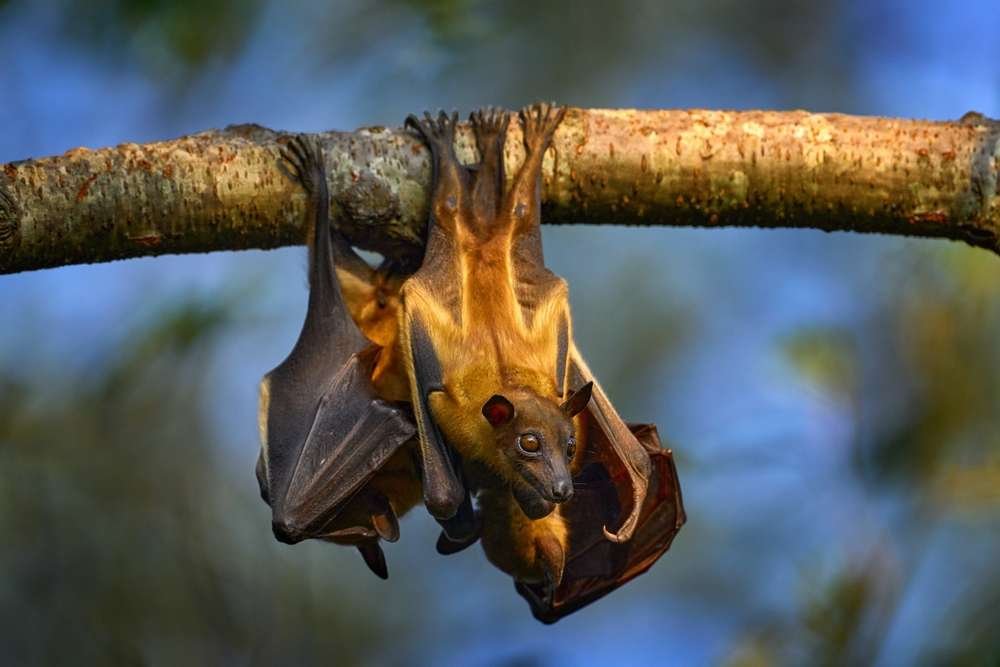African Straw-coloured Fruit Bat
- Eidolon helvum
- IUCN Status: Near Threatened
- Trend: decreasing

- Kingdom: Animalia
- Phylum: Chordata
- Class: Mammalia
- Order: Chiroptera
- Family: Pteropodidae
- Genus: Eidolon
Share:
General Information
The African straw-coloured fruit bat was named based on its yellow grass coloured fur. It is the second-largest fruit bat in Africa. It is a common sight in Zambia, where it plays an important role in the ecosystem as a seed disperser.
Fun Facts
Straw-coloured fruit bats travel in massive colonies of at least 100,000 bats and sometimes massing up to 1 million. From October to end of December every year, in the largest migration of mammals on the planet, up to 10 million straw-coloured fruit bats congregate in Kasanka National Park, Zambia, roosting in a 2 hectare area of Mushitu forest each day. The bats travel up to 500 kilometers to reach Kasanka. This migration was only discovered in 1980. The bats roost in the Mushitu swamp forest, which is one of the largest and most well-preserved swamp forests in Africa.
Description
The African straw-coloured fruit bat has a wingspan of up to 1 meter and weighs up to 350 grams. It has straw-colored fur on its back and wings, and its belly is a lighter color. Males are generally larger than females. The bat’s heart is very large, and its wings are long and tapered at the tip. The cheeks of the bat are also large and pouch-like. The wings are black, and the back hair is pale and tawny. Males are generally bright orange and females are usually yellowish. The bats have large cheeks, eyes, and ears.- Length: 14 to 23 cm and 1m wingspan
- Weight: up to 350g
Ecology & Behaviour
The African straw-coloured fruit bat is a frugivore, meaning that its diet consists mainly of fruits. It also eats leaves, flowers, and nectar.
The African straw-coloured fruit bat breeds once a year. Females give birth to a single pup after a gestation period of about 6 months. Pups are weaned at about 3 months old and reach sexual maturity at about 1 year old.
The African straw-coloured fruit bat is a social animal and lives in colonies of up to 10 million individuals. These colonies roost in trees during the day and emerge at night to forage for food.
Conservation
It is listed as, “Near Threatened” on the International Union for Conservation of nature (IUCN Red list).
Distribution & Habitat
The straw-coloured fruit bat is the most widely distributed fruit bat in Africa, and perhaps the world. It appears mainly in Africa, mostly among the sub-Saharan climates, in many forest and savanna zones, and around the southwestern Arabian peninsula. It can also be found in urban areas and at altitudes up to 2,000 m. It prefers tall trees for roosting.
Interaction with Humans
The African straw-coloured fruit bat is a fascinating and important creature. It is important to protect these bats and their habitat so that they can continue to play their vital role in the ecosystem. The straw-coloured fruit bat is hunted as bushmeat in West and Central Africa.
No donation to this project yet.
| M | T | W | T | F | S | S |
|---|---|---|---|---|---|---|
| 1 | 2 | 3 | 4 | 5 | 6 | |
| 7 | 8 | 9 | 10 | 11 | 12 | 13 |
| 14 | 15 | 16 | 17 | 18 | 19 | 20 |
| 21 | 22 | 23 | 24 | 25 | 26 | 27 |
| 28 | 29 | 30 | 31 | |||


